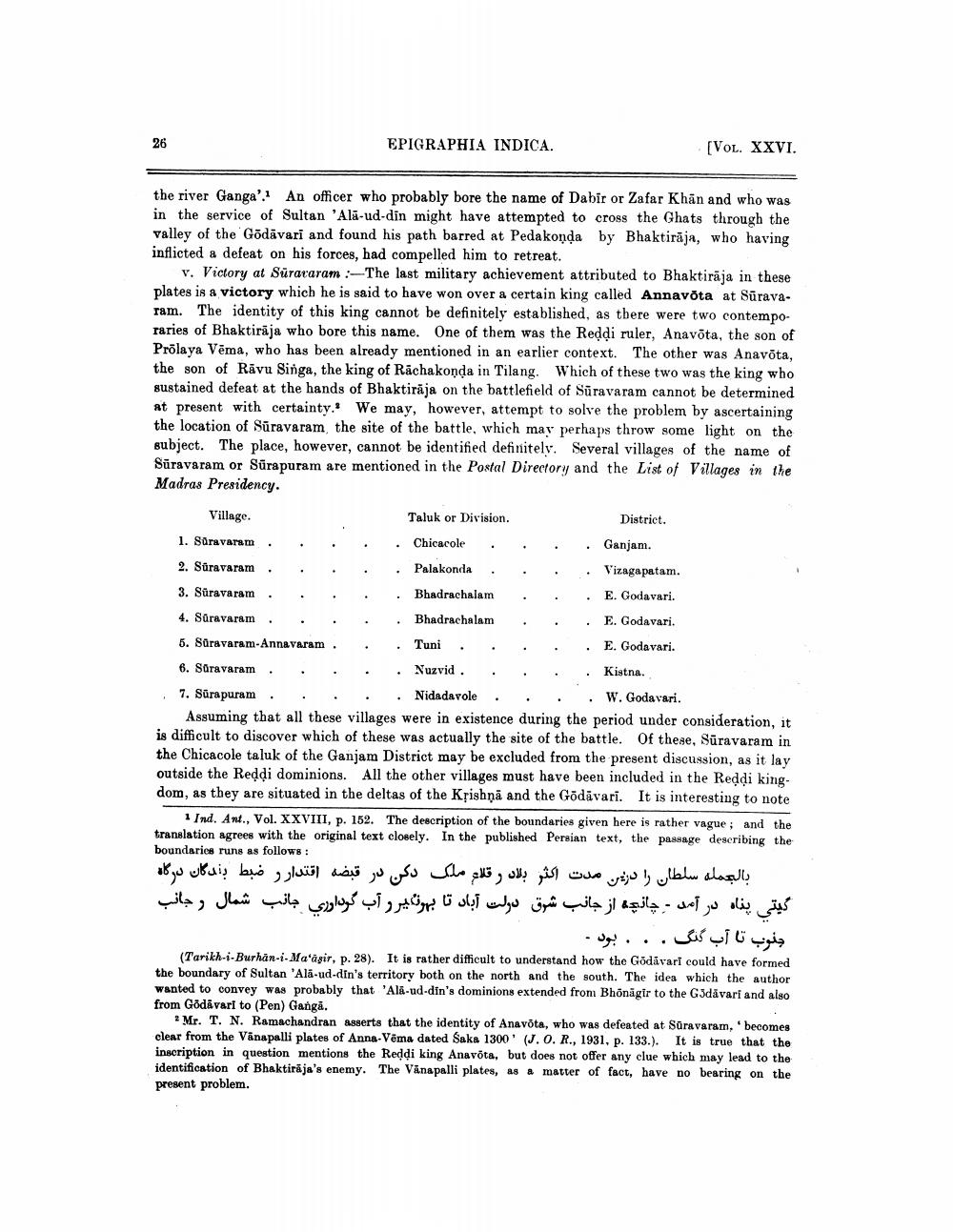________________
EPIGRAPHIA INDICA.
[Vol. XXVI.
the river Ganga': An officer who probably bore the name of Dabir or Zafar Khan and who was in the service of Sultan 'Ala-ud-din might have attempted to cross the Ghats through the valley of the Gõdāvari and found his path barred at Pedakonda by Bhaktirāja, who having inflicted a defeat on his forces, had compelled him to retreat.
v. Victory at Sürararam -The last military achievement attributed to Bhaktiraja in these plates is a victory which he is said to have won over a certain king called Annavõta at Süravaram. The identity of this king cannot be definitely established, as there were two contemporaries of Bhaktirāja who bore this name. One of them was the Reddi ruler, Anavõta, the son of Prolaya Vēma, who has been already mentioned in an earlier context. The other was Anavõta, the son of Rāvu Singa, the king of Rachakonda in Tilang. Which of these two was the king who sustained defeat at the hands of Bhaktiraja on the battlefield of Sūravaram cannot be determined at present with certainty. We may, however, attempt to solve the problem by ascertaining the location of Suravaram, the site of the battle, which may perhaps throw some light on the subject. The place, however, cannot be identified definitely. Several villages of the name of Sūravaram or Surapuram are mentioned in the Postal Directory and the List of Villages in the Madras Presidency.
Village. Taluk or Division.
District. 1. Säravaram . . . . . Chicacole . . . . Ganjam. 2. Süravaram . . . . . Palakonda . . . . Vizagapatam. 3. Süravaram . . . . . Bhadrachalam . . E. Godavari. 4. Sūravaram . . .
Bhadrachalam . . E. Godavari. 6. Saravaram-Annavaram . . Tuni . . . . E. Godavari. 6. Saravaram . . . . .Nuzvid . . . . Kistna. 7. Sūrapuram . . . Nidadavole . . . W. Godavari.
Assuming that all these villages were in existence during the period under consideration, it is difficult to discover which of these was actually the site of the battle. Of these, Süravaram in the Chicacole taluk of the Ganjam District may be excluded from the present discussion, as it lay outside the Reddi dominions. All the other villages must have been included in the Reddi kingdom, as they are situated in the deltas of the Ksishņā and the Gödāvari. It is interesting to note
1 Ind. Ant., Vol. XXVIII, p. 152. The description of the boundaries given here is rather vague; and the translation agrees with the original text closely. In the published Persian text, the passage describing the boundaries runs as follows:
دکن در قبضه اقتدار ر ضبط بندگان درگاه بالجمله سلطان را درین مدت اکثر بلاد رقلاع ملک
شمال و جانب
جانب گیتی پناه در آمد . چانچه از جانب شرق دولت آباد تا بهروزیرر آب گرداوری
- So...a voi vain (Tarikh-i-Burhan-i-Ma'āgit, p. 28). It is rather difficult to understand how the Godavari could have formed the boundary of Sultan 'Ala-ud-din's territory both on the north and the south. The idea which the author wanted to convey was probably that 'Ali-ud-din's dominions extended from Bhönägir to the G3dāvari and also from Gödāvari to (Pen) Ganga.
Mr. T. N. Ramachandran asserts that the identity of Anavõta, who was defeated at Saravaram, 'becomes clear from the Vanapalli plates of Anna Vēma dated Saka 1300' (J.O. R., 1931, p. 133.). It is true that the inscription in question mentions the Reddi king Anavõta, but does not offer any clue which may lead to the identification of Bhaktiraja's enemy. The Vanapalli plates, as a matter of fact, have no bearing on the present problem.




